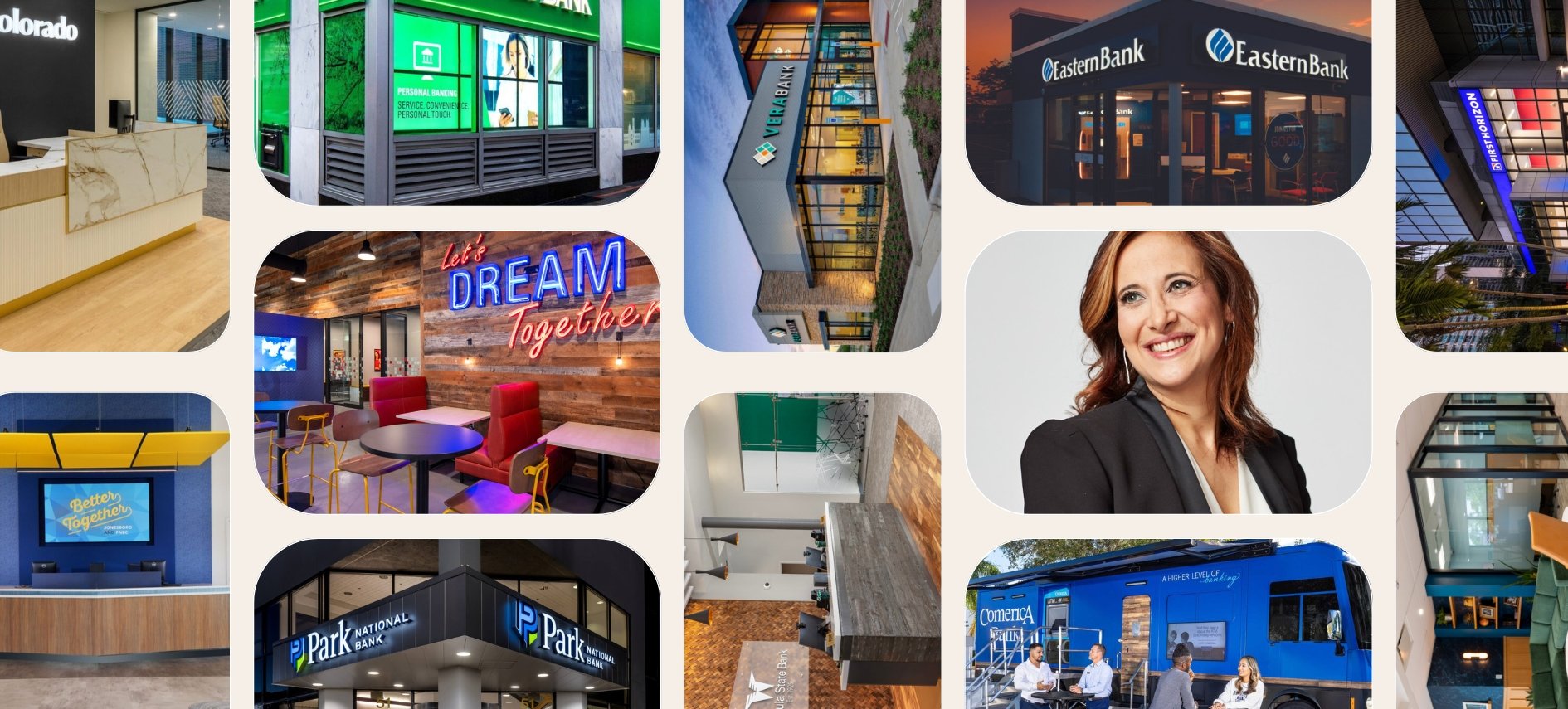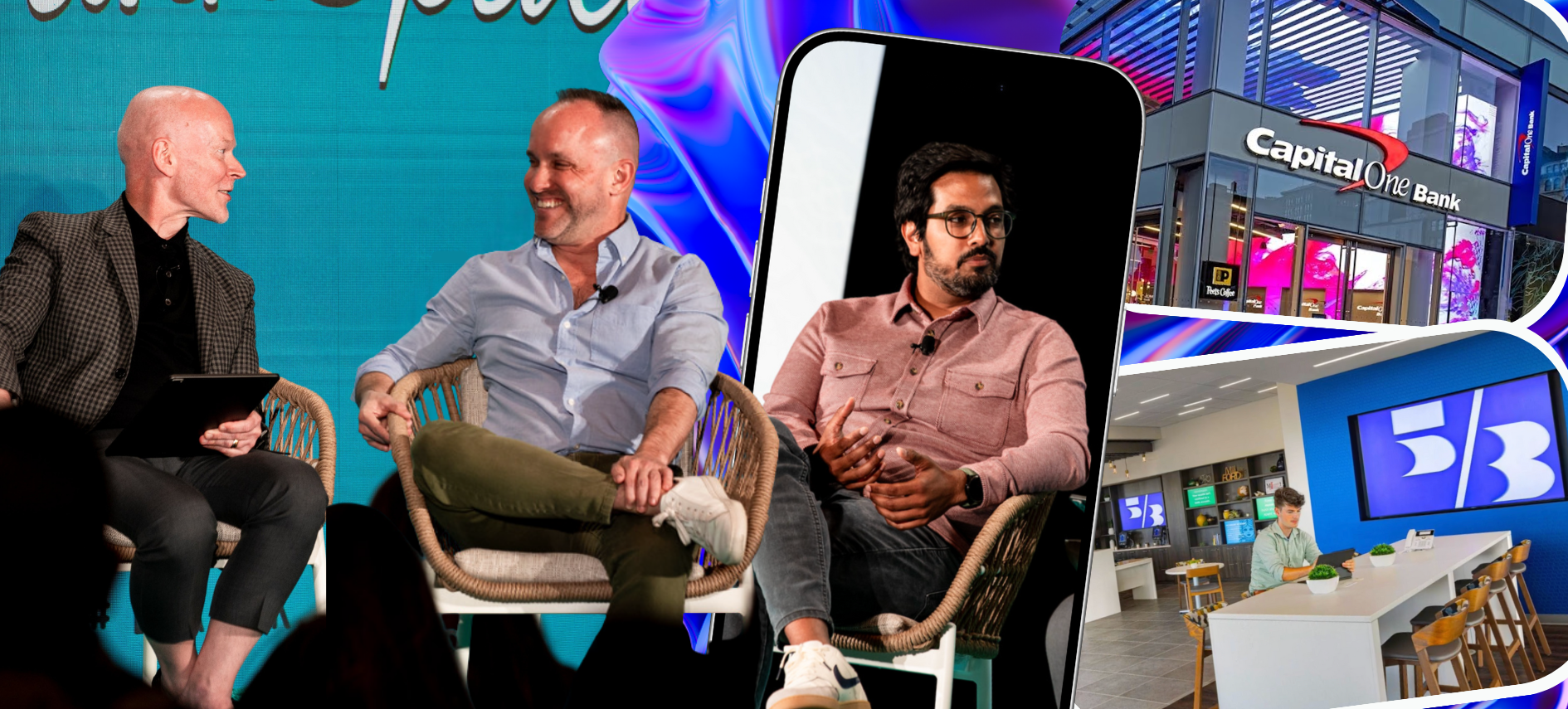Gina Bleedorn is well-known in the retail banking world. She’s a sought-after speaker at events nationwide, co-hosts a popular podcast, and her keen insights are shared far and wide on social media. Bleedorn also has a progressive vision for the future of bank branches, persistently challenging the "branches are obsolete" narrative.
Bleedorn is a firm believer in the enduring relevance of physical branches and that they are here to stay. As the President and CEO of Adrenaline, Bleedorn's insights are especially anticipated at BankSpaces, where she will be a featured speaker (May 5-7 in Palm Springs, CA).
You may not know this fun fact, but Bleedorn majored in vocal performance as an undergrad at Furman University. While her career path might not have led to the stage, her sage-like wisdom has helped illuminate the way forward for banks and credit unions.
She has a voice – and if you are in the business of designing, refreshing, or transforming bank branches, well, you need to listen to her. It might very well help you to sing a different song.
BankSpaces sat down with Bleedorn to discuss why bank leaders need to be more open to risk, what the future holds, and how to stand out in what she calls “a sea of sameness.”
You’ve said that banking leaders need to be more open to risk. How can they do that while also being mindful of capital constraints?
Bleedorn: They need to be receptive to change. Many leaders equate change with risk, but in reality, it's quite the opposite. If you are not open to change, particularly when you're succeeding – with increasing deposits, growing loans, and a seemingly stable status quo – that's actually the most challenging time to implement change, even if it's strategically beneficial for the future.
Being open to the potential impacts of change on your organization and people is crucial. This includes altering processes, staff, expectations, and delivery models. The real opportunity lies in transforming perceived risk into opportunity. It's vital to recognize that a greater danger lies in inaction.
Your capital is what it is. You must strategize on where to save to fund growth. This involves some risk, such as the risk of attrition or the need to make tough choices like consolidating operations – closing two branches and opening a new one, for example. Such strategies can be perceived positively by customers and the community as reinvestment with the opening of new facilities, even if it's actually a move to cut operational expenses, reduce formats, increase technological reliance, or decrease staff numbers.
The goal is to identify savings that can be redirected to foster growth within your network. Failing to invest in growth is tantamount to preparing to be acquired; it's a slow demise. Working within your capital limitations is essential; the tighter those constraints, the more critical the efficiency decisions become.
From a physical retail perspective, how can branches stand out in what you called “A Sea of Sameness?”
Bleedorn: There are two key dimensions to consider on a macro level: the visual and the operational, both of which are crucial. Within the confines of banking business requirements, there is room to innovate both visually and operationally in how services are delivered, particularly in a physical space.
True innovation involves tapping into what makes your institution unique and leveraging that to provide services in a way that only you can offer. Adopting technology like iPads on a tech bar is not enough just because it's trendy. Many have done this, and while it may enhance the ‘cool factor’ to some degree, it's essential to think more deeply about how your brand can stand out visually in a distinctive, ownable way.
Consider your color palette: if every other business uses green, perhaps you could introduce yellow into your branding to differentiate. Also, think about your brand's texture and pattern and how it presents itself. Consistency and scalability are also vital. For instance, when you enter a Starbucks anywhere in the world, there's a recognizable aesthetic consistency along with local adaptations. Determine your brand's consistent feel and the extent to which it can adapt based on local market nuances.
Operationally, this is where the more significant changes and investments come into play, which might be perceived by some leaders as riskier. The shift from transactional to consultative interactions is imperative for the future viability of your branch network. This shift will influence everything from hiring practices to training and from the services offered to the customer's physical journey within the space. Constructing an operational model centered around what customers genuinely desire is essential.
The quicker you can achieve this transformation, the more your institution will distinguish itself, as many competitors have yet to begin to make these operational changes.
What are some actionable insights for banks and credit unions to improve their marketing in their physical locations?
Bleedorn: Consider the contrast between the trackability and metrics of digital marketing versus those of physical branch marketing: it spans from having every possible data point to facing a complete lack of information. With the rise of sophistication and the ability for personalized interaction in digital channels, tracking in the physical, one-to-many channel is less advanced.
Externally, branches should capitalize on their physical space, like a billboard, utilizing available retail windows or drive-through spaces for maximum visibility, primarily focusing on customer acquisition.
Inside the branch, the focus shifts to cross-selling. Blending digital with static displays is the key to attracting attention from the outside to the inside. Digital displays are particularly effective because they compete with the omnipresence of personal screens, and they're easier to update than static fixtures. Static merchandising remains relevant for more evergreen content, like permanent window displays, but for changeout marketing, digital is the way to go.
For digital content, a thoughtful playlist strategy is essential, one that balances the mix, frequency, and segmentation of content. Segmentation doesn't need to be complex; simple macro archetypes assigned to branches can guide the proportion of cross-sell content. This should be integrated into a broader marketing context that includes infotainment, education, branding, and messaging about channel migration.
There are also proven, replicable strategies for using digital marketing tools within a branch that are not overly complex. A well-planned digital marketing approach in the branch can significantly boost both acquisition and cross-selling in a way that many institutions have yet to realize. As owners of the physical channel, optimizing its use to its full potential is crucial for growth.
How can retail banking leaders get the most bang for their capital budget bucks? What should be their primary focus?
Bleedorn: The essence of a smart retail strategy is focused on perceived convenience, which is demonstrated by the success of prominent institutions like JPMorgan Chase. Their physical branch presence is the leading factor in customer acquisition. The goal is to maximize efficiency: minimizing square footage and real estate costs while maximizing impact – also known as the 'billboard' effect.
When considering how to allocate spending, strive to reach a critical mass of branch presence in each market. Evidence shows that achieving this critical mass can potentially double your market share relative to your branch share. Critical mass doesn't require large branches; it can be achieved through a mix of branch sizes and types. For instance, in an urban area, reaching critical mass might mean having six branches, not all of which need to be full-scale. Some could be smaller, unmanned ITM vestibules, which provide a point of presence at a fraction of the operational and capital expense.
The aim is to cultivate a sense of convenience in the consumer's mind. This means opting for smaller, more efficient branch formats in new market deployments. In existing markets, consider consolidating branches or reducing their size. This approach balances a lean operational footprint with a strong perceived presence.
What might the branch of 2034 look like?
Bleedorn: The foot traffic in branches is expected to decrease, becoming a fraction of what we see today. Branches will also be smaller, say around 1,200 square feet in size. The service model will shift away from transactions towards being largely appointment-based, similar to scheduling a session with a specialist. While visiting a bank hasn’t traditionally been as enjoyable as other appointments, it's necessary and helpful. Customers might find themselves visiting perhaps once every five years or maybe annually for a financial check-in, but these visits provide real value to customers and a real opportunity for banks.
This shift to an annual in-person relationship for fine-tuning financial plans could prove beneficial. Banks that adopt this model cater to an annual check-up mentality, which customers are willing to pay for, especially when it aligns with services like financial planning.
There's a vast, yet underserved market ranging from emerging to established wealth, including Gen Z folks navigating their first home purchases, for example. These consultative centers will precisely meet the needs of this demographic, aligning with the reduced frequency of in-person visits.
---------------
Interested in hearing more from Gina Bleedorn? Well, join us at BankSpaces, taking place May 5-7, in Palm Springs, CA. Learn more here.
Posted by
Branching into Tomorrow – Together.
Exploring the Future of Bank Branch Design + Technology
April 19-21, 2026 | Bonita Springs, FL




-Dec-04-2025-03-32-25-8096-PM.png)
-1.png)




Comments